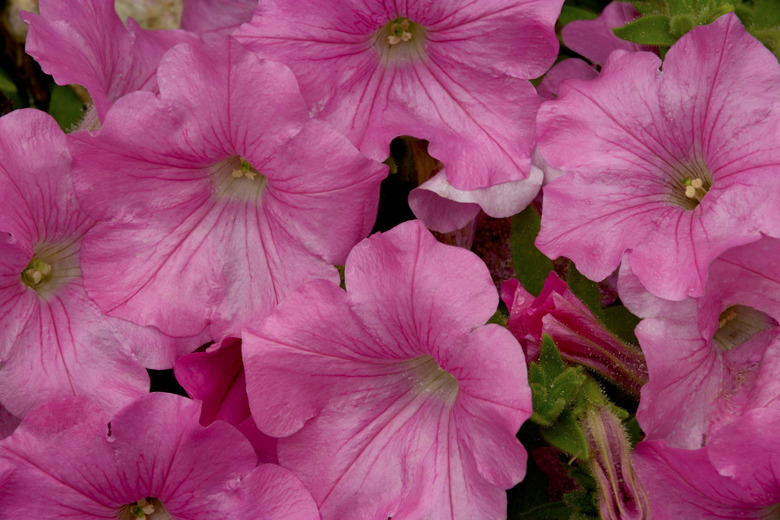Which Bugs Eat Petunias?
Finding the cause at the root of the decline of a petunia (Petunia x hybrida) is often challenging due to the small size of many insects that feed on this plant. Many of the smaller pests that attack petunias pose little threat to a healthy plant, but severe infestations of weakened plants or larger pests can cause serious damage. Petunias grow as perennials in U.S. Department of Agriculture hardiness zones 9 to 10 but are commonly grown as annuals elsewhere.
Mites
Mites are diminutive pests that are difficult or impossible to spot. Petunias host two basic types of mites known as spider mites and cyclamen mites. Spider mites appear as tiny moving dots to the naked eye and are roughly four times the size of cyclamen mites, which are invisible without a magnifying glass. These pests pierce the leaves of petunias to suck out their contents. Petunias suffering from a mite infestation often have leaves with a fine stippling of light-colored spots that eventually leads to general discoloration before the leaves drop from the plant. A stiff spray of water directed at the underside of affected leaves dislodges these pests and prevents them from causing further damage.
- Finding the cause at the root of the decline of a petunia (Petunia x hybrida) is often challenging due to the small size of many insects that feed on this plant.
- Petunias suffering from a mite infestation often have leaves with a fine stippling of light-colored spots that eventually leads to general discoloration before the leaves drop from the plant.
Thrips
Thrips are another small pest that feed on the juices of petunia leaves. These pests leave behind discolored flecks that give the plant's leaves a silver coloration, with tiny black spots dotting the leaves. These winged pests typically measure less than one-twentieth of an inch in length and are highly mobile, moving from plant to plant. Thrips can be difficult to control, notes the University of California, Davis, though cultural controls like keeping the area free of weeds can help. For stubborn infestations, see "Spraying for Control."
Caterpillars
Caterpillars such as the tobbacco budworm can cause heavy damage to petunias. These insects chew holes in foliage, stems and flowers. The tobbacco budworm feeds on unopened flower buds and the petals of flowers, ruining the aesthetics of petunias. The variegated cutworm feeds on the roots and foliage of petunias and eventually emerges to feed on the plant's main stem. Tobbacco budworm is controllable with hand removal, but cutworms are best controlled by tilling. Tilling flowerbeds every spring helps destroy any larvae overwintering in the soil.
- Thrips are another small pest that feed on the juices of petunia leaves.
- The tobbacco budworm feeds on unopened flower buds and the petals of flowers, ruining the aesthetics of petunias.
Slugs
Slugs are common garden pests that feed on the leaves and petals of petunias, leaving behind irregularly shaped holes and severed foliage. Damaged leaves and trails of silvery mucus on or around a petunia are a common sign of slug activity. These pests are controllable with hand removal, but removing landscaping timbers, rocks and other shady places in the garden where slugs commonly hide during the day ensures long-term control.
Leaf Miners
Leaf miners are the larval form of a fly that burrows inside petunia leaves, leaving meandering trails of dead white tissue visible on top of the leaf. The adult flies also feed on leaves, but puncture the leaves to suck out their juices, leaving a stippled pattern of discolored spots in their wake. In most cases leaf miners only result in cosmetic damage. Pruning off infested leaves showing evidence of extensive tunneling is an effective way to control these pests. Always sterilize pruners with a bleach or alcohol solution before and after use to prevent the spread of disease.
- Slugs are common garden pests that feed on the leaves and petals of petunias, leaving behind irregularly shaped holes and severed foliage.
- Leaf miners are the larval form of a fly that burrows inside petunia leaves, leaving meandering trails of dead white tissue visible on top of the leaf.
Aphids
Aphids are small insects with a semi-transparent green or white bodies that suck out the juices of leaves. In moderate numbers, aphids are relatively harmless, but large infestations can cause discoloration and curling of petunia leaves. Aphids also leave behind sticky honeydew, which attracts ants and makes a fertile breeding ground for sooty mildew. Aphids are slow moving and light infestations are easily dislodged with a jet water.
Spraying for Control
Severe infestations of spider mites, aphids or thrips are treatable using insecticidal soap concentrate mixed at a rate of 5 tablespoons per gallon of water. Insecticidal soaps are only effective when they completely coat the infested foliage. Wearing pants, long sleeves, gloves and goggles is an effective way to prevent contact with skin and eyes.
- Aphids are small insects with a semi-transparent green or white bodies that suck out the juices of leaves.
- In moderate numbers, aphids are relatively harmless, but large infestations can cause discoloration and curling of petunia leaves.
References
- Floridata: Petunia x Hybrida
- Unviersity of California Integrated Pest Management Online: Broad Mite, Cyclamen Mite
- Unviersity of California Integrated Pest Management Online: Spider Mites
- Unviersity of California Integrated Pest Management Online: Thrips
- Unviersity of California Integrated Pest Management Online: Leafminers
- Unviersity of California Integrated Pest Management Online: Aphids
- Unviersity of California Integrated Pest Management Online: Pests In Gardens and Landscapes – Petunia
